最新高中英语语法大全-精讲教程18090
最新高考英语语法知识讲解(完整版)
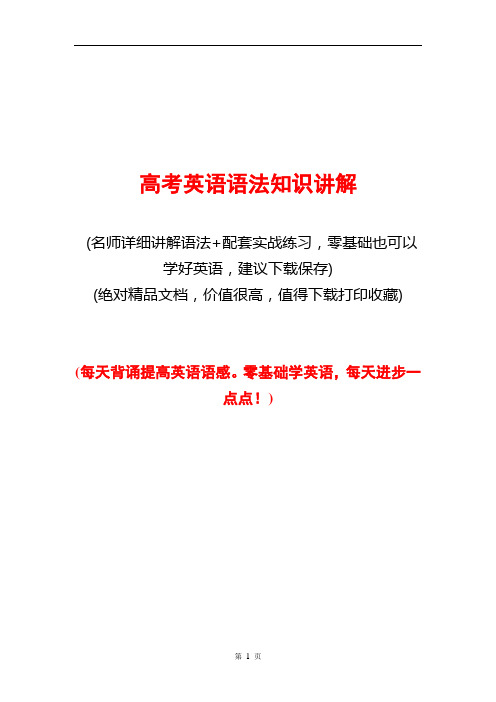
高考英语语法知识讲解(名师详细讲解语法+配套实战练习,零基础也可以学好英语,建议下载保存)(绝对精品文档,价值很高,值得下载打印收藏)(每天背诵提高英语语感。
零基础学英语,每天进步一点点!)第一讲座:名词---基础篇一、名词的复数:1. 名词变复数的规则形式:1). 一般情况下直接加s:book------books cup-----cups2). 以辅音字母+y结尾的,先变y为i再加es:city-------cities family-----families3). 以s、x、sh、ch结尾的加es:bus-----buses wish------wishes watch------watches4). 以o结尾的多数加S 初中阶段只有三个单词加es:tomato-----tomatoes potato------potatoes hero-----heroes Negroes5). 以f、fe 结尾的,先把f、fe变v 再加es:leaf----leaves self---selves shelf----shelves life----lives thief---thieves 2. 少数名词的复数形式是不规则的:man----men woman---women child----children foot-----feet tooth----teeth mouse---mice3. 单数和复数形式相同:deer---deer fish----fish sheep----sheep Chinese ----Chinese Japanese---Japanese4. 某国人的复数:1). 中、日不变:Chinese----Chinese Japanese---Japanese2). 英、法变:Englishman----Englishmen Frenchman----Frenchmen3).其余s加后面:American-----Americans German----Germans Australian---Australians二、不可数名词:1. 不可数名词:1). 不能直接用数字表数量;2). 不能直接加a或an;3). 没有复数形式;4). 可用some、any、lots of、plenty of、much 修饰;5). 可用“量词短语”表示;2. 不可数名词的数量的表示方法:a / 数字+ 量词+ of + 不可数名词:a piece of paper a cup of tea a glass of milk三、名词的所有格:1. ’s 所有格:1). 用and连接两个并列的单数名词表示共有关系时,这时只在最后一个名词后加“’s.”:This is ____________________(Mary and Lily) bedroom.2). 用and连接两个并列的单数名词表示各有关系时,这时分别在每个名词后加“’s.”:These are ________________(Tom and Jack ) school bags.3). 以s结尾的名词,变所有格时在s后加“’”, 不以s 结尾的复数名词,仍加“’s”:Teachers’ Day Children’s Day4). 表示店铺、医院、诊所、住宅等名称时,常在名词后加’s 代表全称:at the doctor’s at the Bob’s5). 由some、any、no、every与one、body 结合的复合不定代词something、anything 等和else 连用时,所有格应加在else的后面:This is _________________(somebody else ) pencil.6). 表示时间、距离、国家、城市等无生命的名词,也可在词尾加’s 来构成所有格:an hour’s ride two weeks’ time China’s capital2. of 所有格:1). of 用来表示无生命的名词所有格:the map of China the door of the room2). 双重所有格:of + 名词所有格of + 名词性的物住代词He is a friend of my _________(brother ).Is she a daughter of __________(you)?四、名词作句子成分:1. 名词作主语:1). 表示时间、金钱、距离作主语时,谓语动词用单数:Two hours ________(be) enough for us to get there.2). 量词短语“数字+量词+ of +…”作主语时,谓语动词应与量词保持一致:A pair of shoes _______(be) under the bed.Two pieces of paper _______(be) on the desk.3). 名词+介词(with、but、except、along with、as well as …….)+名词作主语时,谓语动词应与前面的名词保持一致:The teacher with the students _________(be) planting trees on the hill.4). 短语“neither…nor…、either…or…、not only…but also …”连接主语时,谓语动词实行就近原则:Neither he nor I ______ (be) a Frenchman.2. 名词作定语:1). 名词作定语时,一般用单数形式:There is a shoe factory near the school.2). 名词作定语时,个别情况用复数形式:(sport )The sports meeting will be held next week.3). man、woman 作定语表示性别时,man、woman随后面的名词单复数而变:one man teacher two women teachers第二讲座:名词---提高篇一、名词的单复数:1. 可数名词的复数不规则变化:(1) 单复数同形:deer, sheep, Chinese, means, series, species, works, headquarters(2) 形单意复:people, police, youth, cattle, staff(3) 形复意单:news, physics, politics, maths(4)合成词变复数:passerby→passersby, soninlaw→sonsin-law, lookeron→lookerson, gobetween→go-betweens, grownup→grownups(5) 词形变化:man→men, child→children,tooth→teeth, foot→feet, mouse→mice,medium→media2. 不可数名词的数:(1) 有些抽象名词在具体化时,以复数形式出现;表示特指时,可以和定冠词连用;表示“某种”或“一次”的意义时,可以和不定冠词连用:in surprise“惊讶地”,a surprise“一件令人惊讶的事”;win success“获得成功”,a success“一个/件成功的人/事”;by experience“靠经验”,an experience“一次经历”;with pleasure“乐意”,a pleasure“一件乐事”。
(完整版)高中英语语法总结大全-句子的种类
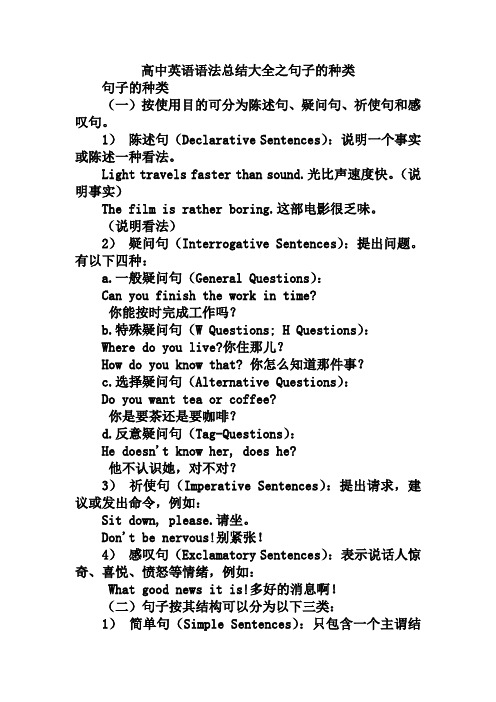
高中英语语法总结大全之句子的种类句子的种类(一)按使用目的可分为陈述句、疑问句、祈使句和感叹句。
1)陈述句(Declarative Sentences):说明一个事实或陈述一种看法。
Light travels faster than sound.光比声速度快。
(说明事实)The film is rather boring.这部电影很乏味。
(说明看法)2)疑问句(Interrogative Sentences):提出问题。
有以下四种:a.一般疑问句(General Questions):Can you finish the work in time?你能按时完成工作吗?b.特殊疑问句(W Questions; H Questions):Where do you live?你住那儿?How do you know that? 你怎么知道那件事?c.选择疑问句(Alternative Questions):Do you want tea or coffee?你是要茶还是要咖啡?d.反意疑问句(Tag-Questions):He doesn't know her, does he?他不认识她,对不对?3)祈使句(Imperative Sentences):提出请求,建议或发出命令,例如:Sit down, please.请坐。
Don't be nervous!别紧张!4)感叹句(Exclamatory Sentences):表示说话人惊奇、喜悦、愤怒等情绪,例如:What good news it is!多好的消息啊!(二)句子按其结构可以分为以下三类:1)简单句(Simple Sentences):只包含一个主谓结构句子叫简单句,例如:She is fond of collecting stamps.她喜欢集邮。
(主)(谓)2)并列句(Compound Sentences):包含两个或两个以上主谓结构的句子叫并列句,句与句之间通常用并列连词或分号来连接,例如:The food was good, but he had little appetite.(主) (谓)(主)(谓)食物很精美,但他却没什么胃口。
(完整版)高中英语语法讲解与练习
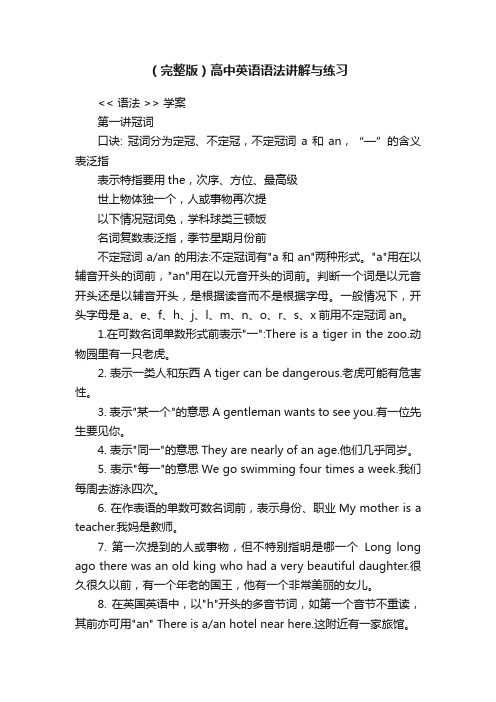
(完整版)高中英语语法讲解与练习<< 语法 >> 学案第一讲冠词口诀: 冠词分为定冠、不定冠,不定冠词a和an,“—”的含义表泛指表示特指要用the,次序、方位、最高级世上物体独一个,人或事物再次提以下情况冠词免,学科球类三顿饭名词复数表泛指,季节星期月份前不定冠词a/an的用法:不定冠词有"a和an"两种形式。
"a"用在以辅音开头的词前,"an"用在以元音开头的词前。
判断一个词是以元音开头还是以辅音开头,是根据读音而不是根据字母。
一般情况下,开头字母是a、e、f、h、j、l、m、n、o、r、s、x前用不定冠词an。
1.在可数名词单数形式前表示"一":There is a tiger in the zoo.动物园里有一只老虎。
2. 表示一类人和东西 A tiger can be dangerous.老虎可能有危害性。
3. 表示"某一个"的意思A gentleman wants to see you.有一位先生要见你。
4. 表示"同一"的意思They are nearly of an age.他们几乎同岁。
5. 表示"每一"的意思We go swimming four times a week.我们每周去游泳四次。
6. 在作表语的单数可数名词前,表示身份、职业My mother is a teacher.我妈是教师。
7. 第一次提到的人或事物,但不特别指明是哪一个Long long ago there was an old king who had a very beautiful daughter.很久很久以前,有一个年老的国王,他有一个非常美丽的女儿。
8. 在英国英语中,以"h"开头的多音节词,如第一个音节不重读,其前亦可用"an" There is a/an hotel near here.这附近有一家旅馆。
(完整版)高中英语语法大全(最新版全国通用)
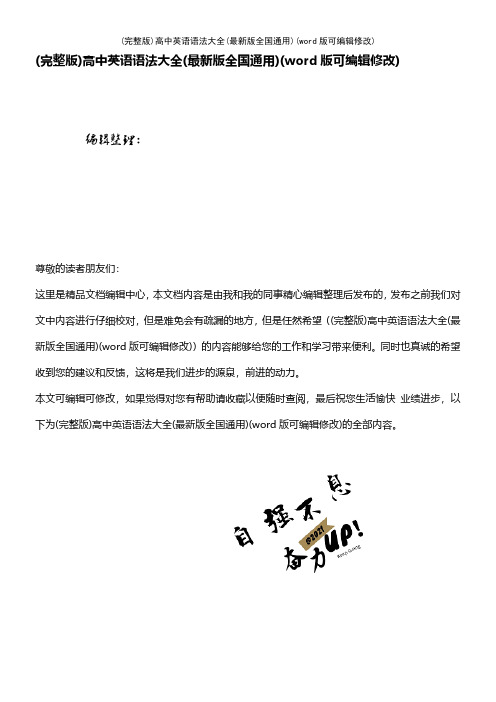
(完整版)高中英语语法大全(最新版全国通用)(word版可编辑修改)编辑整理:尊敬的读者朋友们:这里是精品文档编辑中心,本文档内容是由我和我的同事精心编辑整理后发布的,发布之前我们对文中内容进行仔细校对,但是难免会有疏漏的地方,但是任然希望((完整版)高中英语语法大全(最新版全国通用)(word版可编辑修改))的内容能够给您的工作和学习带来便利。
同时也真诚的希望收到您的建议和反馈,这将是我们进步的源泉,前进的动力。
本文可编辑可修改,如果觉得对您有帮助请收藏以便随时查阅,最后祝您生活愉快业绩进步,以下为(完整版)高中英语语法大全(最新版全国通用)(word版可编辑修改)的全部内容。
(2)派生形容词:①名词+y②名词+ful③动词+ing/ed④friendly⑤dangerous⑥Chinese;Japanese⑦English⑧French⑨German⑩国名+(i)an如:snowy,sunny,hopeful, beautiful, interesting, follwing, daily(每日的),nervous, delicious(3)派生副词:①形容词+ly ②其它,如:slowly, angrily, full→fully,good→well,possible→possibly等等。
3、转换法:(1)形容词→动词,如:dry(干燥的)→dry(弄干),clean(干净的)→clean(打扫,弄干净),等等.(2)动词→名词,如:look, walk, rest, work, study, swim, go, talk等等。
(3)名词→动词,如:hand(手)→(传递),face(脸)→(面对)等等.(4)形容词→副词,如:early→early, fast→fast等等。
(5)副词→连词,如:when(什么时候)→(当……时候),等等。
(6)介词→副词,如:in(到……里)→(在里面;在家),on(在…上)→(进行,继续),等等。
新教材2025版高中英语语法精讲2不定式作定语和结果状语学案牛津译林版必修第三册

语法精讲②不定式作定语和结果状语1.不定式作定语动词不定式作定语,修饰前面的名词或代词(也叫中心词)。
动词不定式跟中心词有逻辑关系,大致分为主谓关系、动宾关系、同位关系和状语关系等。
(1)主谓关系不定式的动作是不定式所修饰的中心词来执行的。
可以改成定语从句。
①不定式可用来修饰人。
He is a man to finish his task best.他是任务完成得最好的人。
→He is a man who has finished his task best.He was a brave man to admit what he had done.他是个敢做敢当的英勇之人。
→He was a brave man who could admit what he had done.②不定式可用来修饰物,表示某物要做某事。
The next train to arrive was from New York.下一列到站的火车是从纽约开来的。
→The next train which would arrive was from New York.The world mathematics conference to take place in Beijing next month is bound to be a great success.下个月将在北京召开的世界数学大会肯定会取得圆满胜利。
→The world mathematics conference which is going to take place in Beijing next month is bound to be a great success.(2)动宾关系不定式与所修饰的中心词有动宾关系,可改成定语从句。
跟主谓关系一样,不定式修饰的既可以是人,也可以是物。
不定式动作的执行者可能是句子的主语,也有可能是句子的宾语;有时不定式动作的执行者暗含在上下文中;有时用for sb./sth.指出动作的执行者;有时根本不知道是谁。
(完整版)高中英语语法复习讲义+训练:动词不定式(含答案),推荐文档

高中英语语法复习讲义——动词不定式一.相关知识点精讲:1.不定式作补语1)有些有动词+宾语+不定式的结构。
例如:例如;Father will not allow us to play on the street. 父亲不让我们在街上玩耍。
The officer ordered his men to fire. 长官命令士兵开火。
注意:有些动词如make,have,get,want 等可用不定式作做宾补,也可用分词作宾补。
现在分词表达主动,也表达正在进行,过去分词表达被动。
2)有些有动词+宾语+不定式的结构,不定式的动词往往是be,不定式一般可以省去。
例如:例如:We believe him to be guilty. 我们相信他是有罪的。
We know him to be a fool. 我们知道他是个笨蛋。
(to be 不能省去)典型例题Charles Babbage is generally considered the first computer.A. to inventB. inventingC. to have inventedD. having invented答案:C. 一般没有consider+宾语+be 以外不定式的结构,也没有consider+宾语+doing 的结构,排除A、B、D。
consider 用动词be 以外的不定式作宾补时,一般要求用不定式的完成式,故选C。
3)有些动词可以跟there +to be 的结构。
例如:believe expect intend like loveprefer want wish understand mean例如:We didn't expect there to be so many people there. 我们没料到会有那么多人在那里。
You wouldn’t want there to be another war. 你不至于想让另外一场战争发生吧。
英语语法讲解大全+练习+keys 共十九讲 总计155页 收编人:靳军强
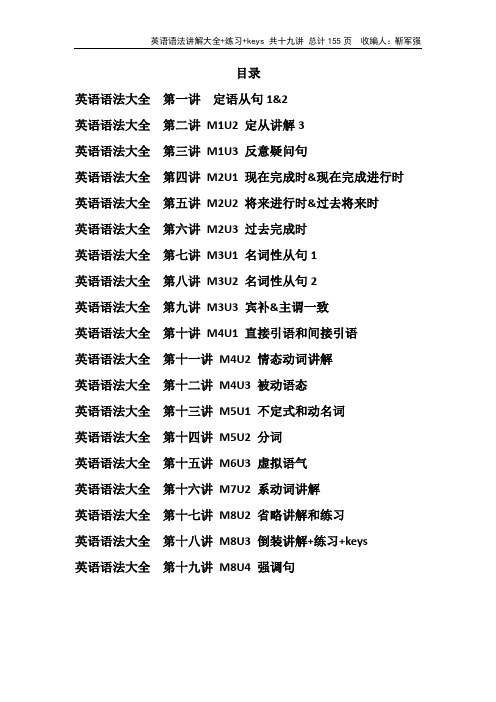
目录英语语法大全第一讲定语从句1&2英语语法大全第二讲M1U2 定从讲解3英语语法大全第三讲M1U3 反意疑问句英语语法大全第四讲M2U1 现在完成时&现在完成进行时英语语法大全第五讲M2U2 将来进行时&过去将来时英语语法大全第六讲M2U3 过去完成时英语语法大全第七讲M3U1 名词性从句1英语语法大全第八讲M3U2 名词性从句2英语语法大全第九讲M3U3 宾补&主谓一致英语语法大全第十讲M4U1 直接引语和间接引语英语语法大全第十一讲M4U2 情态动词讲解英语语法大全第十二讲M4U3 被动语态英语语法大全第十三讲M5U1 不定式和动名词英语语法大全第十四讲M5U2 分词英语语法大全第十五讲M6U3 虚拟语气英语语法大全第十六讲M7U2 系动词讲解英语语法大全第十七讲M8U2 省略讲解和练习英语语法大全第十八讲M8U3 倒装讲解+练习+keys英语语法大全第十九讲M8U4 强调句定语从句The Attributive Clause(I)【教学内容与目的】熟悉关系代词和关系副词的基本用法一、定义:(请先预习Unit One的P8)1.先行词:被定语从句修饰的名词或代词叫做先行词。
2. 定语从句:修饰一个名词或代词的从句称为定语从句。
定语从句通常紧跟在先行词之后。
3. 关联词:引导定语从句的词称为关联词。
关联词包括关系代词和关系副词。
关系代词有that, which, who, whom, whose等;关系副词有where, when, why。
关系词的作用:1.引导定语从句。
2.代替先行词。
3.在定语从句中担当某一成分。
Unit One的P10)1. who指人,在定语从句中做主语。
如:The boys who are playing football are from Senior Grade One.Yesterday I helped an old man who lost his way.2. whom指人,在定语从句中充当宾语,常可省略。
高中英语语法大全-精讲教程(最全版)

去年我参观过故宫博物院。 【正】I have visited the Palace Museum.
我参观过故宫博物院。 b. 表示过去经常发生的动作或存在的状态 I wrote home once a week at college. 我上大学时每周给家里写一封信。 He was already in the habit of reading widely in his boyhood. 他童年时就养成了广泛阅读的习惯。 提示: 表示过去的习惯性动作,除了用过去式外,还可以用 used to 或 would 来表示。 She used to study late into the night when she was in Senior Three. 她上高三时经常学习到深夜。 He would sit for hours doing nothing. 过去他常常一坐几个钟头什么事也不做。 c. 表示过去连续发生的一系列动作 She entered the room, picked up a magazine and looked through it carefully. 她走进房间,拿起一本杂志,认真地翻阅了起来。 The students got up early in the morning, did morning exercises and then read English aloud in the open air. 学生们很早起床,做早操,然后在室外朗读英语。 d. 在时间、条件状语从句中表示过去将要发生的动作 We would not leave until the teacher came back. 老师回来我们才会离开。
【强烈推荐】高一英语上重要语法讲解(2021年整理)
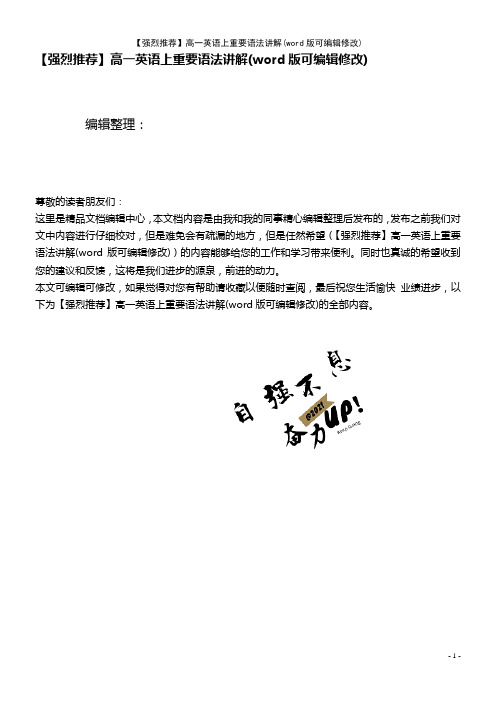
【强烈推荐】高一英语上重要语法讲解(word版可编辑修改)编辑整理:尊敬的读者朋友们:这里是精品文档编辑中心,本文档内容是由我和我的同事精心编辑整理后发布的,发布之前我们对文中内容进行仔细校对,但是难免会有疏漏的地方,但是任然希望(【强烈推荐】高一英语上重要语法讲解(word版可编辑修改))的内容能够给您的工作和学习带来便利。
同时也真诚的希望收到您的建议和反馈,这将是我们进步的源泉,前进的动力。
本文可编辑可修改,如果觉得对您有帮助请收藏以便随时查阅,最后祝您生活愉快业绩进步,以下为【强烈推荐】高一英语上重要语法讲解(word版可编辑修改)的全部内容。
定语从句1。
定语从句的结构及理解2。
定语从句的关系词的使用3. 定语从句的简化表达知识总结归纳(一)定语从句的结构:在复合句中,修饰某个名词或代词的句子(做这个名词或代词的定语)叫定语从句,定语从句一般放在被修饰的名词或代词后面,被修饰的名词或代词叫做定语从句的先行词,它与定语从句之间要有一个词连接,这个词指代先行词的内容叫做关系词(关系代词或关系副词:that, which, who, whose, when, where, why)。
先行词在定语从句中充当主语,宾语,时间,地点,原因状语.结构:先行词+关系词+定语从句。
1。
There she saw a wall of water that was quickly advancing towards her。
2. In Japan, someone who sees another person making the gesture will think it means money.3. A theme park is a collection of rides, exhibitions or other attractions that are based on a common theme。
高中英语语法全英详解无水印

高中英语语法全英详解无水印IMB standardization office【IMB 5AB- IMBK 08- IMB 2C】必修一语法点一:Be+表将来 use the present continuous tense for future plans In English, we have lots of ways of talking about the future. The most common ways of talking about the future we encounter use ‘will’ or ‘be going to’ followed by an infinitive (动词原形), and we tend to use ‘be going to’ most often for talking about future plans.Sometimes, we also use the present continuous tense to talk about future plans.Ex. ①we are going to Mexico next Sunday.② Are you coming to the cinema?③ He is leaving for London in two hours.④ We are spending next winter in Australia.Only some verbs can be used in this situation, such as: go, arrive, come, leave, start, stay, return, play, have, work, wear, spend, see, meet, etc.扩展:What’s the difference between using ‘be going to’ and the present continuous to talk about future plans Let’s look at some more examples:“I’m going to play football on Saturday”You have made a plan in your head but possibly not taken any real action to confirm it. Also, playing football on Saturday is probably not a regular event for you.“I’m playing football on Saturday”You have made a plan and taken some real action to confirm it . called your friends or booked a place to play). In this case, it’s likely that playing football on Saturdays is a common activity for you.语法点二:Direct speech and indirect speech(直接引语和间接引语)Let's first define the terms, then look at how to talk about what someone said, and how to convert speech from direct to indirect or vice-versa.You can answer the question What did he say? in two ways:by repeating the words spoken (direct speech)by reporting the words spoken (indirect or reported speech).Direct speech repeats, or quotes, the exact words spoken. When we use direct speech in writing, we place the words spoken between quotation marks (" ") and there is no change in these words.Reported or indirect speech is usually used to talk about the past, so we normally change the tense of the words spoken. We use reporting verbs like 'say', 'tell', 'ask', and we may use the word 'that' to introduce the reported words. Quotation marks are not used.1、declarative sentence陈述句①Change in pronoun: The pronoun (subject) of the reported speech is changed according to the pronoun of reporting verb or object (person) of reporting verb (first part of sentence). Sometimes the pronoun may not change.In following example the pronoun of reported speech is “I” which will be ch anged in indirect speech into the pronoun (Subject) of reporting verb that is “he”.He said, “I like it very much.”→He said that he liked it very much.②Change in tense: If the first part of sentence (reporting verb part) belongs to past tense the tense of reported speech will change. If the first part of sentence (reporting verb part) belongs to present or future tense, the tense of reported speech will not change.③Change in demonstrative pronoun指示代词, temporal adverbial时间状语, adverbial of place地点状语 and verbs.Ps:(1)if the direct speech indicates objective truth, then there is no change in tense when it’s converted to indirect speech.Ex. He said, “Light travels much faster than sound.”→He said that light travels much faster than sound.(2) 如果在当地转述,here不必改成there,come不必改为go,如果在当天转述,yesterday, tomorrow等时间状语也不必改变。
高中英语语法(全)讲义精讲
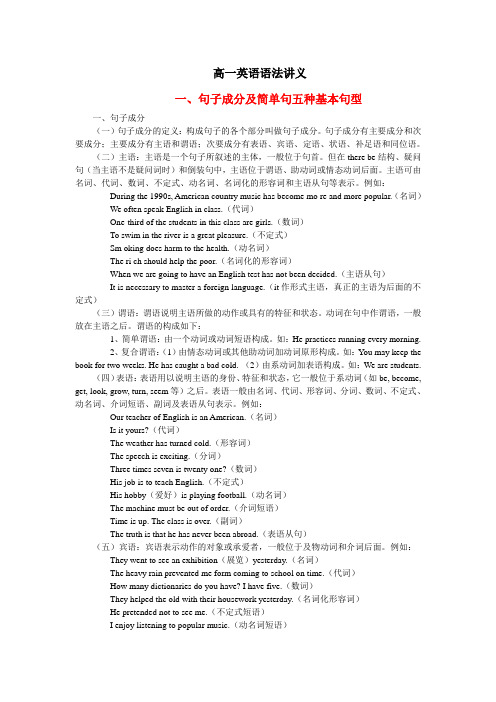
高一英语语法讲义一、句子成分及简单句五种基本句型一、句子成分(一)句子成分的定义:构成句子的各个部分叫做句子成分。
句子成分有主要成分和次要成分;主要成分有主语和谓语;次要成分有表语、宾语、定语、状语、补足语和同位语。
(二)主语:主语是一个句子所叙述的主体,一般位于句首。
但在there be结构、疑问句(当主语不是疑问词时)和倒装句中,主语位于谓语、助动词或情态动词后面。
主语可由名词、代词、数词、不定式、动名词、名词化的形容词和主语从句等表示。
例如:During the 1990s, American country music has become mo re and more popular.(名词)We often speak English in class.(代词)One-third of the students in this class are girls.(数词)To swim in the river is a great pleasure.(不定式)Sm oking does harm to the health.(动名词)The ri ch should help the poor.(名词化的形容词)When we are going to have an English test has not been decided.(主语从句)It is necessary to master a foreign language.(it作形式主语,真正的主语为后面的不定式)(三)谓语:谓语说明主语所做的动作或具有的特征和状态。
动词在句中作谓语,一般放在主语之后。
谓语的构成如下:1、简单谓语:由一个动词或动词短语构成。
如:He practices running every morning.2、复合谓语:(1)由情态动词或其他助动词加动词原形构成。
如:You may keep the book for two weeks. He has caught a bad cold. (2)由系动词加表语构成。
高中英语语法知识梳理大全完整清晰
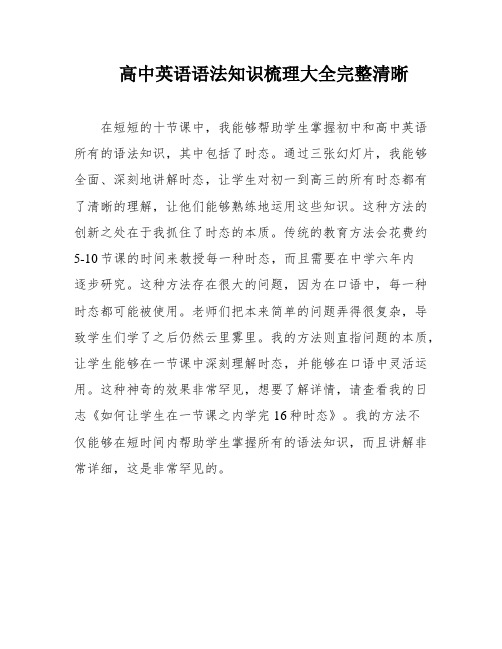
高中英语语法知识梳理大全完整清晰
在短短的十节课中,我能够帮助学生掌握初中和高中英语所有的语法知识,其中包括了时态。
通过三张幻灯片,我能够全面、深刻地讲解时态,让学生对初一到高三的所有时态都有了清晰的理解,让他们能够熟练地运用这些知识。
这种方法的创新之处在于我抓住了时态的本质。
传统的教育方法会花费约
5-10节课的时间来教授每一种时态,而且需要在中学六年内
逐步研究。
这种方法存在很大的问题,因为在口语中,每一种时态都可能被使用。
老师们把本来简单的问题弄得很复杂,导致学生们学了之后仍然云里雾里。
我的方法则直指问题的本质,让学生能够在一节课中深刻理解时态,并能够在口语中灵活运用。
这种神奇的效果非常罕见,想要了解详情,请查看我的日志《如何让学生在一节课之内学完16种时态》。
我的方法不
仅能够在短时间内帮助学生掌握所有的语法知识,而且讲解非常详细,这是非常罕见的。
高中英语重点语法讲义(内部资料).doc
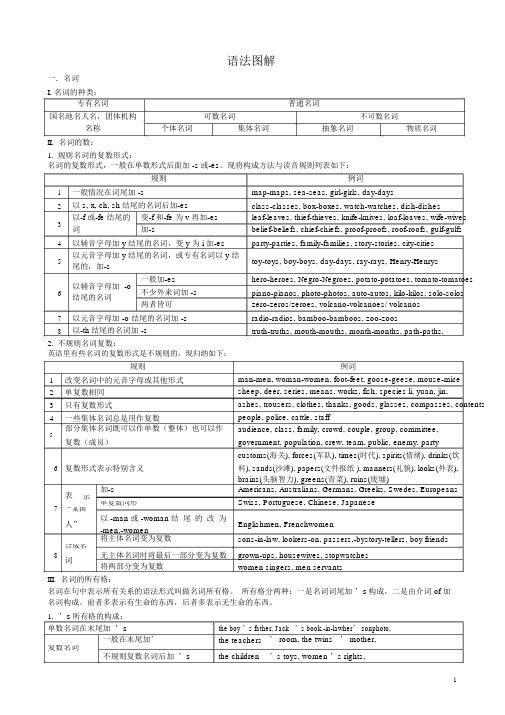
语法图解一.名词I. 名词的种类:专有名词普通名词国名地名人名,团体机构可数名词不可数名词名称个体名词集体名词抽象名词物质名词II.名词的数:1.规则名词的复数形式:名词的复数形式,一般在单数形式后面加 -s或-es。
现将构成方法与读音规则列表如下:规则例词1一般情况在词尾加 -s map-maps, sea-seas, girl-girls, day-days2以 s, x, ch, sh结尾的名词后加-es class-classes, box-boxes, watch-watches, dish-dishes3以-f 或-fe 结尾的变-f 和-fe 为 v 再加-es leaf-leaves, thief-thieves, knife-knives, loaf-loaves, wife-wives 词加-s belief-beliefs, chief-chiefs, proof-proofs, roof-roofs, gulf-gulfs4以辅音字母加 y 结尾的名词,变 y 为 i 加-es party-parties, family-families, story-stories, city-cities5以元音字母加 y 结尾的名词,或专有名词以 y 结toy-toys, boy-boys, day-days, ray-rays, Henry-Henrys尾的,加-s以辅音字母加 -o一般加-es hero-heroes, Negro-Negroes, potato-potatoes, tomato-tomatoes6不少外来词加 -s piano-pianos, photo-photos, auto-autos, kilo-kilos, solo-solos 结尾的名词两者皆可zero-zeros/zeroes, volcano-volcanoes/ volcanos 7以元音字母加 -o 结尾的名词加 -s radio-radios, bamboo-bamboos, zoo-zoos8以-th结尾的名词加 -s truth-truths, mouth-mouths, month-months, path-paths,2.不规则名词复数:英语里有些名词的复数形式是不规则的,现归纳如下:规则1改变名词中的元音字母或其他形式2单复数相同3只有复数形式4一些集体名词总是用作复数部分集体名词既可以作单数(整体)也可以作5复数(成员)例词man-men, woman-women, foot-feet, goose-geese, mouse-mice sheep, deer, series, means, works, fish, species li, yuan, jin,ashes, trousers, clothes, thanks, goods, glasses, compasses, contents people, police, cattle, staffaudience, class, family, crowd, couple, group, committee, government, population, crew, team, public, enemy, partycustoms(海关), forces(军队), times(时代), spirits(情绪), drinks(饮6复数形式表示特别含义料), sands(沙滩), papers(文件报纸 ), manners(礼貌), looks(外表),brains(头脑智力), greens(青菜), ruins(废墟)表加-s Americans, Australians, Germans, Greeks, Swedes, Europeans 示Swiss, Portuguese, Chinese, Japanese7单复数同形“某国人”以 -man 或 -woman 结尾的改为Englishmen, Frenchwomen-men,-women将主体名词变为复数sons-in-law, lookers-on, passers,-bystory-tellers, boy friends8合成名grown-ups, housewives, stopwatches 词无主体名词时将最后一部分变为复数将两部分变为复数women singers, men servantsIII.名词的所有格:名词在句中表示所有关系的语法形式叫做名词所有格。
最新高考英语语法讲解大全(120页)
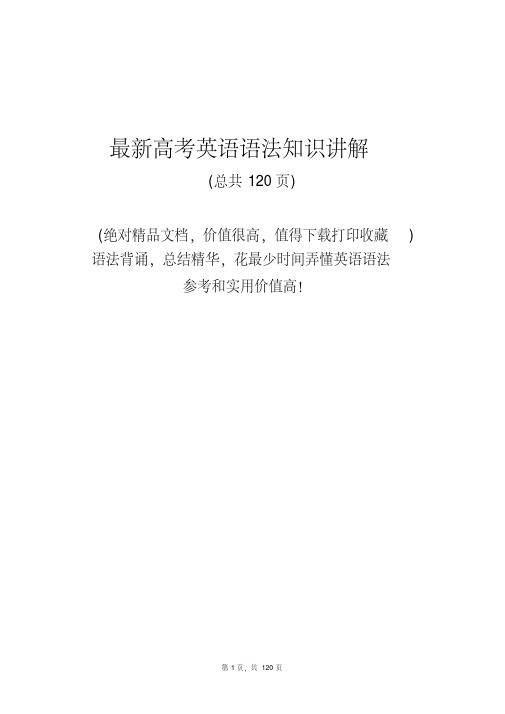
最新高考英语语法知识讲解(总共120页)(绝对精品文档,价值很高,值得下载打印收藏) 语法背诵,总结精华,花最少时间弄懂英语语法参考和实用价值高!第一讲词性一、名词名词可以分为专有名词和普通名词,专有名词是某个(些)人,地方,机构等专有的名称,如Beijing,China等。
普通名词是一类人或东西或是一个抽象概念的名词,如:book,sadness等。
普通名词又可分为下面四类:1)个体名词:表示某类人或东西中的个体,如:gun2)集体名词:表示若干个个体组成的集合体,如:family3)物质名词:表示无法分为个体的实物,如:air4)抽象名词:表示动作、状态、品质、感情等抽象概念,如:work个体名词和集体名词可以用数目来计算,称为可数名词,物质名词和抽象名词一般无法用数目计算,称为不可数名词。
归纳一下,名词的分类可以下图表示:名词专有名词不可数名词普通名词物质名词抽象名词集体名词可数名词个体名词1.1 名词复数的规则变化情况构成方法读音例词一般情况加-s 清辅音后读/s/ map-maps浊辅音和元音后读/z/ bag-bags /car-cars以-s, -sh, -ch, -x等结尾加-es 读/iz/ bus-buses/ watch-watches以-ce, -se, -ze,等结尾加-s 读/iz/ license-licenses以辅音字母+-y结尾变-y 为-i再加es 读/z/ baby---babies1.2 其它名词复数的规则变化1)以-y结尾的专有名词,或元音字母+-y 结尾的名词变复数时,直接加-s变复数。
如:two Marys the Henrysmonkey---monkeys holiday---holidays2)以-o 结尾的名词,变复数时:a. 加s,如:photo---photos piano---pianosradio---radios zoo---zoos;b. 加es,如:potato--potatoes tomato--tomatoesc. 上述a和b两种方法均可,如zero---zeros / zeroes3)以-f或-fe 结尾的名词变复数时:a. 加s,如:belief---beliefs roof---roofssafe---safes gulf---gulfs;b. 去-f, -fe 加-ves,如:half---halvesknife---knives leaf---leaves wolf---wolveswife---wives life---lives thief---thieves;c. 上述a和b两种方法均可,如handkerchief: handkerchiefs / handkerchieves1.3 名词复数的不规则变化1)child---children foot---feet tooth---teethmouse---mice man---men woman---women注意:由一个词加man 或woman构成的合成词,其复数形式也是-men 和-women,如an Englishman,two Englishmen。
(完整)高中英语语法知识梳理大全完整清晰,推荐文档

10 来节课补完初中,高中英语所有语法!三张幻灯片就将时态讲得非常全面深刻,把初一到高三的所有时态用一节课讲得清清楚楚,且让学生滚瓜烂熟,运用自如,这是一个非常巨大的创新,之所以能够实现是因为抓住了时态的本质。
时态一共16 种,传统教育学一种就要花约5-10 节课,学完要花100 多节课,且要分为中学六年来学习,这是一个极大的错误,因为口语中每一种时态都可能用到。
而且老师把本来特别简单的问题弄得很复杂,以至于学生学了还是云里雾里。
我的方法一针见血,直击本质。
不但一节课深刻理解,而且还能灵活运用到口语中。
敢问世界还有谁能做到如此神奇效果。
想了解是怎样实现的。
请看日志《如何让学生在一节课之内学完16 种时态》,看了我是如何做到的也就非常相信了。
不但承诺在10 来节课补完,补好初中,高中英语所有语法知识,而且讲解细化到了这种程度,实属非常罕见。
一张幻灯片总结清楚冠词的主要用法,熟练掌握冠词只需5 分钟不到。
高中生普遍学不好虚拟语气,有的学了几年也没能弄清楚,可是到了我这儿,只需两句话10 分钟就讲得清清楚楚!!“”“”At the end, Xiao Bian gives you a passage. Minand once said, "people who learn to learn are very happy people.". In every wonderful life, learning is an eternal theme. As a professional clerical and teaching position, I understand the importance of continuous learning, "life is diligent, nothing can be gained", only continuous learning can achieve better self. Only by constantly learning and mastering the latest relevant knowledge, can employees from all walks of life keep up with the pace of enterprise development and innovate to meet the needs of the market. This document is also edited by my studio professionals, there may be errors in the document, if there are errors, please correct, thank you!。
“高中英语课件:必备语法知识”

日常口语表达常用的语法知识和技巧
形容词和副词的使用
1ห้องสมุดไป่ตู้形容词
描述人、地点和事物的形容 词用法和修辞手法
2 副词
修饰动词、形容词和其它副 词的使用技巧
3 修辞手法
排比、对比和比喻等修辞手法的说明和应用
情态动词的用法
1
情态动词简介
情态动词的意义和分类
情态动词的使用
2
情态动词在语法中的重要作用和使用技巧
3
常见例句
贴近生活的情态动词例句,加深理解
并列、从属、倒装句等基本句型
并列句
两个或多个并列的句子,构成完 整的语法结构
从属句
引导词介绍和从属句使用技巧
倒装句
语序倒装的句子类型和例句解释
主谓一致原则及其它语法规则
主谓一致原则
通过语法规则判断主语和谓 语间的一致性
各种修饰语的规则
插入语、状语和定语的使用 技巧和特殊情况
介词、冠词等常用词
介词、冠词和其它常见词汇 的使用和相应填空技巧
句子成分的分析和归纳
1 句子成分简介
句子的部分和构造形成的说 明和例子
2 主语和谓语
主谓构成的基础句式介绍和 应用技巧
3 宾语和介词短语
宾语和介词短语的使用技巧和例子解释
语气和语调的表达方式
1
语气的分类
陈述语气、祈使语气和虚拟语气的语法分类
2
语调的表达方式
语言音调和情绪的关系,以及练习方法
3
口语表达技巧
高中英语课件:必备语法 知识
本课程将涵盖高中英语必备的所有语法知识,帮助您轻松掌握英语语法。
语法分类及基本概念
名词、代词
两个基础词类的介绍和相关 用法
- 1、下载文档前请自行甄别文档内容的完整性,平台不提供额外的编辑、内容补充、找答案等附加服务。
- 2、"仅部分预览"的文档,不可在线预览部分如存在完整性等问题,可反馈申请退款(可完整预览的文档不适用该条件!)。
- 3、如文档侵犯您的权益,请联系客服反馈,我们会尽快为您处理(人工客服工作时间:9:00-18:30)。
第一主题高中英语语法系统全解(一)第1章动词时态2-4楼第2章被动语态5-7 楼第3章虚拟语气9-11 楼第4章情态动词12-16楼第5章动词不定式17-20 楼第6章动词的ing形式21-24楼第7章过去分词25-27楼第8章独立主格结构28-30楼第9章名词性从句31-33楼第10章定语从句35-40楼第11章状语从句(一)40-45楼第11章状语从句(二)第12章直接引语和间接引语第13章倒装第14章强调第15章省略第16章主谓一致动词时态--一般时第一章动词时态(一)在英语中,不同时间发生的动作或存在的状态,要用不同的动词形式来表示,这就叫做动词的时态。
一、一般时一般时包括一般现在时、一般过去时、一般将来时和一般过去将来时。
A.一般现在时1.一般现在时的构成一般现在时主要用动词原形来表示。
主语是第三人称单数时,动词后面要加-s或-es。
They want good jobs.他们想要好的工作。
The coat matches the dress.外衣和裙子很相配。
This work does not satisfy me.这项工作我不满意。
Do you understand?你懂了吗?2.一般现在时的用法①一般现在时的基本用法a. 表示现在习惯性的动作或存在状态He always takes a walk after supper.晚饭后他总是散散步。
Everyone is in high spirits now.现在大家都情绪高涨。
b. 表示客观事实或普遍真理The sun rises in the east and sets in the west.太阳从东方升起在西方落下。
Sound travels faster through water than it does through air.声音在水中的传播速度要比在空气中快。
Time and tide wait for no man.时间不等人。
c. 表示主语的特征、能力和状态This cloth feels soft.这布摸上去很软。
I love classical music.我喜欢古典音乐。
The President still seems able to find time to go fishing.看来总统仍能有时间去钓鱼。
d. 表示按计划或安排将要发生的动作The meeting begins at 7:00.会议七点钟开始。
We leave here at 8:00 sharp.我们八点整离开这里。
e. 在时间、条件、让步状语从句中表示将来动作When you come next time, bring me some magazines.你下次来时,给我带几本杂志。
If time allows, we shall go there tomorrow.如果时间允许的话,我们明天去那里。
Whether he agrees or not, I will stay at home.不管他同意与否,我都会待在家里。
②一般现在时的特殊用法a. 用于新闻标题或图片说明中China Declares Manned Spaceflight Successful中国宣布载人航天飞行圆满成功Laura Bush Arrives in Moscow劳拉·布什抵达莫斯科b. 用于体育运动、表演等实况报道中Francis slips past, passes the ball to Yao Ming, who jumps, catches and shoots it into the basket.弗朗西斯穿过去,把球传给姚明,姚明跳起来,接住球投进篮里。
Now, look, I press the button and turn on the machine.现在,看,我按下按扭,打开了这台机器。
c. 表示告诫或劝说You mind your own business.你不要管闲事!If he does that again, he goes to prison.如果他再那样的话,他就会进监狱的。
d. 表示现在瞬间的动作Here comes the bus.汽车来了。
There goes the bell.铃响了。
B.一般过去时1.一般过去时的构成一般过去时是用动词的过去式来表示。
His words fetched a laugh from all present.他的话使在场的人都笑了。
I did not sleep well last night.我昨晚没睡好。
Did you direct the tourist to the hotel?你告诉这位游客去旅馆的路了吗?2.一般过去时的用法①一般过去时的基本用法a. 表示过去某个特定时间发生的动作或存在的状态He suddenly fell ill yesterday.昨天他突然生病了。
The engine stopped because the fuel was used up.发动机因燃料用光而停机了。
注意:在一般过去时的句子中,通常都要有表示过去的时间状语。
【误】I visited the Palace Museum.(在没有上下文的情况下,应避免这样说)【正】I visited the Palace Museum last year.去年我参观过故宫博物院。
【正】I have visited the Palace Museum.我参观过故宫博物院。
b. 表示过去经常发生的动作或存在的状态I wrote home once a week at college.我上大学时每周给家里写一封信。
He was already in the habit of reading widely in his boyhood.他童年时就养成了广泛阅读的习惯。
提示:表示过去的习惯性动作,除了用过去式外,还可以用used to或would来表示。
She used to study late into the night when she was in Senior Three.她上高三时经常学习到深夜。
He would sit for hours doing nothing.过去他常常一坐几个钟头什么事也不做。
c. 表示过去连续发生的一系列动作She entered the room, picked up a magazine and looked through it carefully.她走进房间,拿起一本杂志,认真地翻阅了起来。
The students got up early in the morning, did morning exercises and then read English aloud in the open air.学生们很早起床,做早操,然后在室外朗读英语。
d. 在时间、条件状语从句中表示过去将要发生的动作We would not leave until the teacher came back.老师回来我们才会离开。
She told me she would not go if it rained the next day.她告诉我如果第二天下雨的话,她就不去了。
②一般过去时的特殊用法a. 在虚拟语气中表示现在或将来时间的动作或状态It's time we went.是我们该走的时候了。
I wish I were twenty years younger.但愿我年轻20岁。
I would rather you didn't do anything for the time being.我宁愿你暂时先不要采取什么措施。
b. 在口语中,一般过去时往往显示委婉客气。
I wondered if you could give me a hand.我想请你帮个忙。
Might I come and see you tonight?我想今晚来看你,好吗?3.一般现在时和一般过去时的比较一般现在时要和现在时间相联系,而一般过去时和说话的“现在”不相联系。
His father is a film director.他父亲是电影导演。
(他现在还是)His father was a film director.他父亲曾是电影导演。
(他现在不是)How do you like the novel?你觉得这部小说怎么样?(还在看小说)How did you like the novel?你觉得这部小说怎么样?(已看完小说)C.一般将来时1.一般将来时的构成一般将来时是由“will / shall + 动词原形”构成的。
shall只限于第一人称,主要见于英国英语,现在的趋势是第一、二、三人称的单复数形式均用will表示。
在口语中,shall和will常缩写成“'ll”,紧接在主语之后。
其否定式shall not 和will not 常简略为shan't 和won't。
I'll go and shut the door.我去关门。
When will you know your exam results?你什么时候能知道考试结果?I can see you're busy, so I won't stay long.我看得出你很忙,所以我不会呆太久的。
提示:在you and I或both of us等短语后,只用will,不用shall。
You and I will arrive there next Monday.我和你下周一都要到达那里。
Both of us will graduate from middle school next year.我们俩明年中学毕业。
2.一般将来时的用法①表示将要发生的动作或存在的状态I shall be free this afternoon.我今天下午有空。
There'll be no chemistry classes tomorrow.明天没有化学课。
They will probably go to Shanghai for their holiday.他们可能去上海度假。
注意:在口语中,常用will / shall + be doing结构来代替will / shall + 动词原形,以表示生动。
I'll be seeing a friend off at the airport.我要去机场给一个朋友送行。
He'll be going with us tomorrow.他明天和我们一起去。
②表示将要反复发生的动作My uncle will come to see me every Saturday.我叔叔每个星期六都会来看我。
